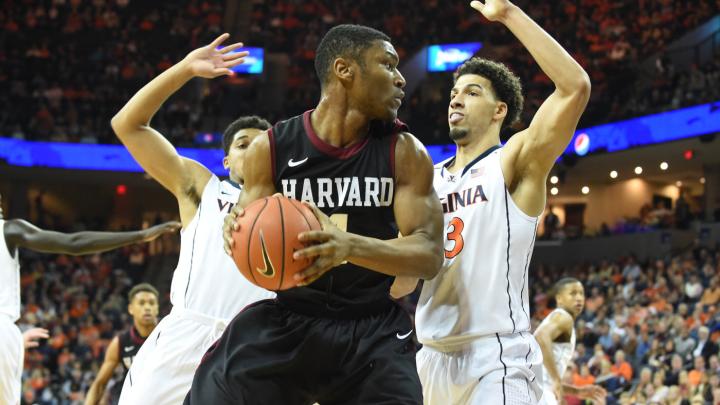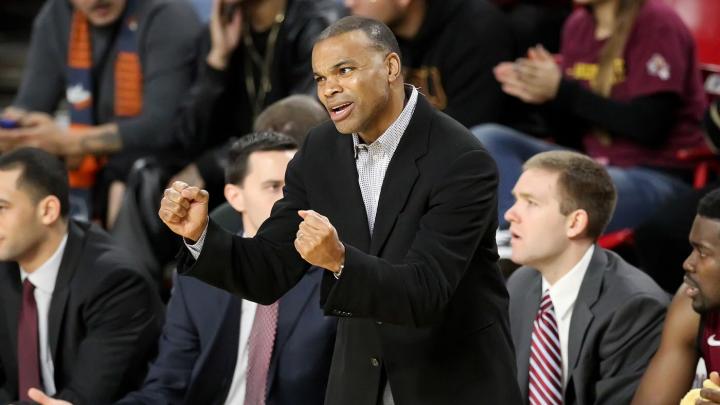Harvard Hardwood, the Harvard Magazine basketball report
In November 2007, Tommy Amaker began his tenure as Harvard men’s basketball coach with a 111-56 loss to twenty-third-ranked Stanford. A little over seven years later, on December 22, Amaker’s squad suffered the second most-lopsided defeat of his stint in Cambridge: a 76-27 thrashing by the third-ranked* University of Virginia.
Although the margin of defeat against the Cavaliers was slightly narrower, the blowout in Charlottesville was decidedly more disappointing. Whereas the 2007-2008 squad was expected to struggle, this year’s team was ranked twenty-fifth nationally in the pre-season AP poll. But following their ignominious defeat in Virginia, a subsequent 56-46 loss to Arizona State, and a 72-59 win over Grand Canyon, the Crimson face questions about whether they have the offensive balance and poise to win a fifth consecutive Ivy League title.
A One- (or Two-) Man Show?
Heading into this season, Amaker emphasized that reigning Ivy League Player of the Year Wesley Saunders ’15 and junior co-captain Siyani Chambers were the team’s “best” and “most important” players, respectively. For much of the year, the tandem excelled. Entering the match-up with Virginia, Saunders was the only player in the country averaging at least 20 points, seven rebounds, and four assists per game; and Chambers was leading the league with 5.8 assists per contest.
But during the team’s recent three-game swing, Harvard discovered the danger of relying so heavily on one or two players. Against Virginia, Saunders and Chambers shot a combined 0 for 17 from the field, and Chambers registered zero assists. At Arizona State, Saunders tallied 15 points, but the Sun Devils pulled away during the second half when Saunders went to the bench with cramps and Chambers—who had four turnovers and one assist in the game—failed to lead the attack. As Amaker said after the game, the Crimson’s offense was “not very good.”
Given the probability that Saunders and Chambers will have off nights (and the inevitability that opposing defenses will focus on them), one of the most important questions facing the Crimson is how they will score more points. A simple answer should come at the free-throw line. Last year, the team sank 72.6 percent of its free-throw attempts, the second-highest rate in the league. Against Virginia, Harvard made only 9 of 22 attempts; and during its trip to Arizona, the Crimson made merely 25 of 41 of its attempts (61 percent) from the charity stripe. Harvard must rediscover its form at the line.
A bigger and more vexing issue will be who can help Saunders shoulder the scoring load. Last year, all five Harvard starters averaged at least 9.7 points per game and Saunders led the squad with 14.2 points per contest. Similar balance and depth are lacking this year: Saunders averages 17.7 points per game, more than twice the average of the next leading scorers. Last year’s team was adept at moving the ball in the half court, but this year’s team has often been content to run an isolation play for Saunders with the shot clock winding down. Given that Saunders is an All-American candidate, having the ball in his hands frequently is logical; but as the Virginia game demonstrated, relying on him too heavily is risky.
If Harvard is to win the league again, Chambers, the point guard, will need to be more aggressive in finding his shot, and he will have to make sure that Corbin Miller ’15 (’17), senior co-captain Steve Moundou-Missi, and Kenyatta Smith ’15 (among others) become more involved in scoring.
On-Court Leadership
Equally important to the team’s prospects will be the players’ ability to demonstrate poise: to lead one another when opponents challenge them—as their predecessors did. Last year’s squad had several players—most notably Kyle Casey ’13 (’14)—who exuded confidence and relished the opportunity to play with the proverbial targets on their backs. Before Casey, Oliver McNally ’12 helped spur the team to its first two league crowns.
 Harvard Hardwood
Harvard Hardwood
Sign up for Harvard Magazine’s basketball e-mail and follow the Crimson all season long! David L. Tannenwald ’08 will provide the latest news, game summaries, and insights as the Crimson chase another Ivy title and NCAA berth!
In contrast, the team’s performance during the last three games betrayed a lack of conviction. Following the Virginia loss, Amaker lamented that the squad had started to “sulk” in the second half; and before the Grand Canyon match-up, according to Moundou-Missi, the coach emphasized that the team needed to play with “purpose” and “fight until the end.”
That the players responded by convincingly defeating the Antelopes—a squad that had recently knocked off a strong New Mexico team—demonstrated progress; but Harvard will need to sustain that focus and confidence throughout conference play, led by the upperclassmen.
The Path Ahead
Although the lopsided loss to Virginia was unnerving, fans should not overreact. The Cavaliers were a number-one seed in last year’s NCAA tournament and might actually be better this year. Moreover, the game came immediately after a two-week break for final exams. Although every squad in the country has exams, as Amaker told his team, Kenyatta Smith faced a major challenge, going from sitting for a final on Thursday afternoon to guarding a seven-foot-tall, Atlantic Coast Conference-caliber center 72 hours later.
Nonetheless, if Amaker is to fulfill his vision of establishing one of the best basketball programs in the country, his players need to be able compete with the top teams in the country throughout the season. For now, the coach has a more immediate concern: if Harvard drops consecutive games during league play, this year’s team will likely have something far more objectionable than a lopsided defeat in common with Amaker’s first Harvard squad: it will be watching the NCAA tournament from home.
Tidbits:
• Shortly after the Virginia game, Harvard Athletics announced that the Crimson will participate in next December’s Diamond Head Classic in Hawaii. The field has several traditionally strong programs, including Oklahoma and New Mexico, the team the Crimson upset in the 2013 NCAA tournament. And despite playing thousands of miles from home, the Crimson will have at least one prominent local fan: former Honolulu mayor—and 2014 Hawaiian gubernatorial candidate—Mufi Hannemann ’76 played varsity basketball at Harvard.
• Although Harvard’s road trip produced mixed results, sophomore Zena Edosomwan impressed. One of the most highly touted recruits in school history, the power forward played sparingly as a freshman. Against the Cavaliers, Edosomwan tallied Harvard’s first field goal. He scored two field goals against Arizona State and got to the free-throw line three times against Grand Canyon. Although Edosomwan amplified the team’s free-throw woes by sinking only one of six shots, his impact in the post, if sustained, would be a real asset for the team as league play approaches.
• Just before the Christmas break, the Harvard women’s basketball squad defeated Northeastern, which is coached by former Crimson assistant Kelly Cole, thanks to a game-winner from AnnMarie Healy ’16. In late December, the Crimson then split two games at a tournament at Georgia Tech, before beginning the New Year with a 68-58 loss at home versus Florida Gulf Coast, continuing a pattern of serial wins and losses. The women’s team (now 6-6) will host Chattanooga on January 5 before beginning league play against Dartmouth on January 10.
* The University of Virginia was ranked third at the time this post was published in early January, but was ranked fifth when Harvard played them in December.










